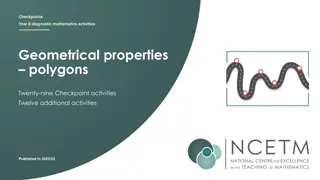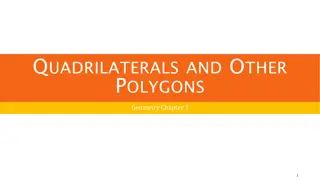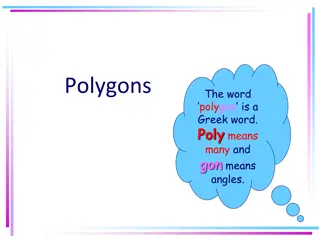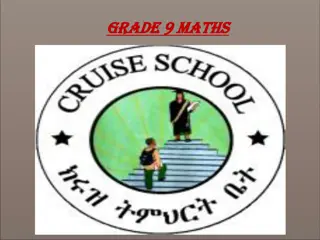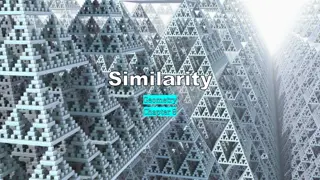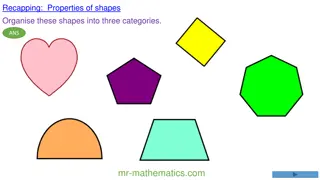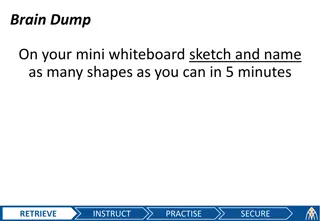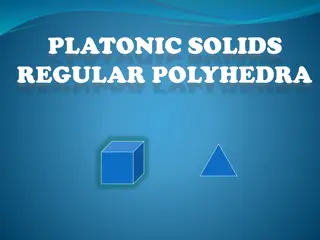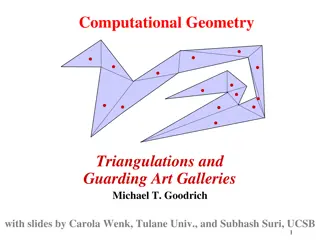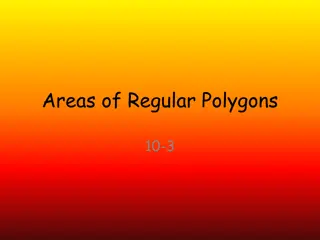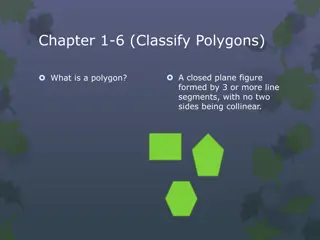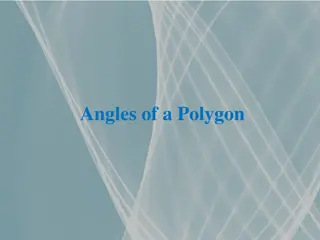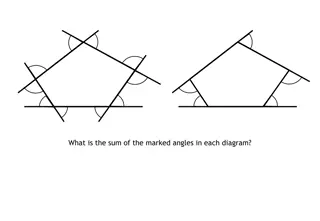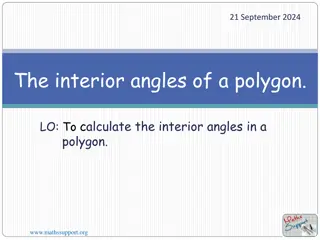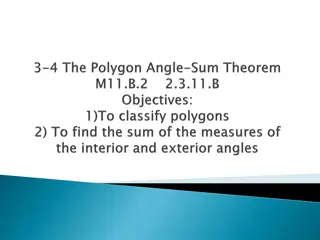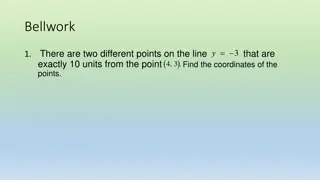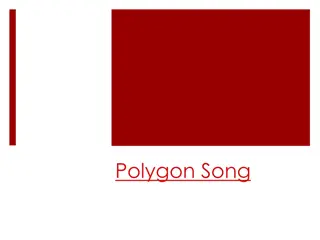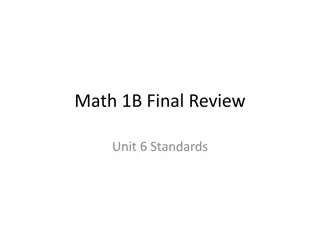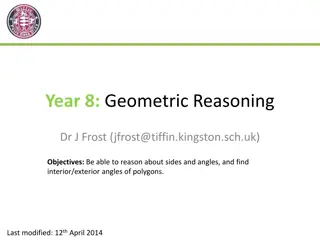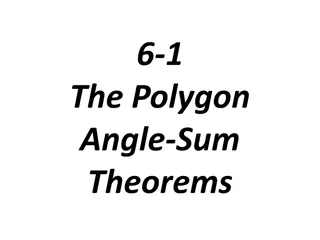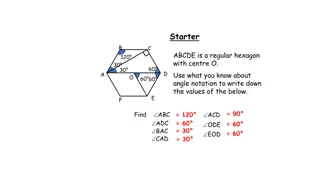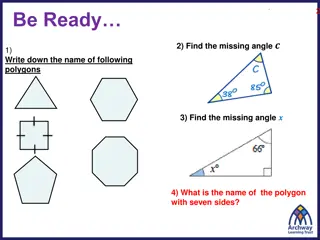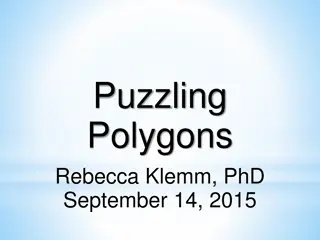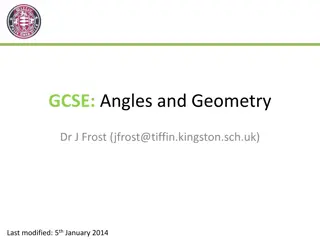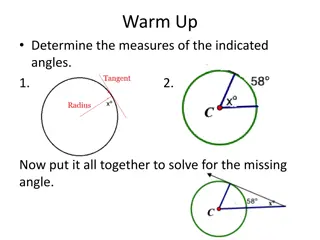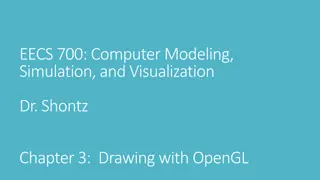Year 8 Mathematics Checkpoints - Geometrical Properties of Polygons
Explore the Year 8 Mathematics Checkpoints focusing on geometrical properties of polygons. Discover activities, underpinning codes, and essential concepts related to angles, line segments, and shapes. Delve into intriguing questions like angles of 400 degrees, bottle lids turning, and angle estimati
6 views • 86 slides
Polygon Angles in Geometry
Explore the interior and exterior angle measures of polygons, understand theorems related to polygon angles, classify polygons based on their properties, and solve problems involving regular polygons in this geometry chapter slideshow. The content covers key concepts such as the sum of interior angl
3 views • 41 slides
Polygons: Shapes with Many Angles
Explore the world of polygons, two-dimensional closed figures composed of straight line segments. Learn about their characteristics, types like equiangular and equilateral polygons, and examples of regular polygons.
1 views • 46 slides
Discovering Geometry and Measurement Concepts in Grade 9 Mathematics
Explore the fundamentals of geometry and measurement in grade 9 math, covering topics such as regular polygons, congruence and similarity of triangles, construction of similar figures, trigonometric ratios application, circle properties, and problem-solving related to triangles and parallelograms. U
0 views • 17 slides
Similar Polygons in Geometry
Explore the concept of similar polygons in geometry through a comprehensive slideshow developed to accompany the textbook "Big Ideas Geometry" by Larson and Boswell. Learn to identify corresponding lengths, perimeters, and areas of similar polygons, make similarity statements, and determine similari
0 views • 24 slides
Properties and Construction of Polygons
Discover the properties of shapes and how to organize them into categories, including regular polygons and measuring their angles. Dive into constructing polygons like triangles, quadrilaterals, pentagons, and hexagons with their interior and exterior angles. Learn more about regular and irregular p
5 views • 10 slides
Filling Polygons Using Scan Line Algorithm
Learn how to fill polygons using the Scan Line Algorithm, which involves intersecting scan lines with polygon edges and filling the area between intersections. Steps include finding Ymin and Ymax, intersecting scan lines with edges, sorting intersection points, and filling the interior of the polygo
4 views • 36 slides
Similar Polygons and Ratios in Geometry
Discover the concept of similar polygons in geometry, identifying congruent angles and corresponding sides, solving proportions, and applying properties to solve problems. Delve into the vocabulary, principles, and examples of similar polygons to gain a comprehensive understanding of the topic. Expl
4 views • 21 slides
Calculating Areas of Geometric Shapes
Explore the concept of finding the area of trapezoids, rhombuses, kites, and regular polygons using visual aids and explanations. Learn about the measurements needed, such as base, height, apothem, and more, to determine the area accurately. Practice calculating areas of various polygons like decago
1 views • 17 slides
2D Shapes and Polygons
Uncover the world of 2D shapes and polygons with a brain dump session, identifying common shapes like triangles, quadrilaterals, and polygons with Greek and Latin numerical prefixes. Learn the distinguishing features of shapes, symbols used to represent key characteristics, and how markings denote e
7 views • 27 slides
Regular Polyhedra and Polygons
Regular polygons and polyhedra are fundamental shapes in geometry. A regular polygon has sides and angles that are congruent, such as equilateral triangles and squares. Polygons are simple closed figures made with line segments. Polyhedra are solids bounded by polygons as faces. Regular polyhedra ar
5 views • 18 slides
Computational Geometry: Triangulations and Art Gallery Guarding
Explore the concepts of triangulations and guarding art galleries in computational geometry. Learn about the problem of placing cameras or guards strategically in an art gallery to ensure every point is visible. Discover how polygons are defined, the variations in guarding strategies, and the use of
5 views • 31 slides
Areas of Regular Polygons
Explore the definitions, formulas, and theorems related to regular polygons, including central angles, apothems, and perimeter calculations. Learn how to find the area of a regular polygon through examples and solutions.
4 views • 11 slides
Polygons: Classifying Shapes with Multiple Sides
Explore the world of polygons, closed plane figures consisting of three or more line segments. Learn about convex and concave polygons, different classifications based on the number of sides, and properties of congruent polygons. Dive into examples and problems to deepen your understanding.
6 views • 7 slides
Angles of Polygons
Exploring interior and exterior angles of polygons, including regular and convex polygons, through informative images. Learn about the relationships between interior and exterior angles and their properties in polygons.
3 views • 12 slides
Geometry Angle Sum and Properties Exploration
Dive into the world of geometry with various diagrams and scenarios focusing on angle sums, concave and convex polygons, and angle measurements. Learn about properties of polygons and test your skills in identifying different shapes and their classifications based on their properties. Explore angles
1 views • 18 slides
Interior Angles in Polygons
Explore the concept of interior angles in polygons, including definitions of polygons, convex and concave polygons, regular and irregular polygons, as well as the sum of interior angles in triangles and quadrilaterals. Discover the naming convention for polygons based on their number of sides and le
3 views • 16 slides
Polygon Properties and Classification
Explore the fundamental concepts of polygons, such as vertices, sides, angles, and classifications like convex and concave polygons. Learn about the interior and exterior angles of polygons, the sum of angle measures, and the properties of regular polygons. Discover how to identify, classify, and ca
5 views • 13 slides
Raster Graphics and Scan Conversion in Computer Graphics
This lecture covers various topics related to raster graphics and scan conversion in computer graphics. It includes issues with scan converting a line, generalized line drawing algorithms, and the midpoint circle drawing algorithm. Additionally, it explores deriving mathematical expressions for draw
0 views • 21 slides
Geometry in the Coordinate Plane
The content discusses various topics related to geometry in the coordinate plane, including finding points on a line that are a specific distance apart, classifying polygons by their sides, determining perimeters of polygons with given vertices, and calculating areas of triangles and polygons. It pr
3 views • 12 slides
Fun with Polygons and Shapes
Explore the world of polygons and shapes through a playful and educational journey, learning about triangles, squares, rhombuses, hexagons, and more. Discover the unique characteristics of parallelograms, quadrangles, and right angles, all presented in a fun and interactive way with catchy songs and
3 views • 5 slides
Math Review: Distance, Midpoint, Polygons, and Reasoning
Solve distance and midpoint problems, identify polygons, and practice reasoning skills in this comprehensive math review covering topics like coordinate geometry, polygons, and mathematical reasoning techniques.
2 views • 20 slides
Geometric Reasoning for Year 8 Students
Explore geometric reasoning with Dr. J. Frost's lessons on identifying 2D polygons, properties of quadrilaterals, interior angles of shapes, and the sum of interior angles in polygons. Test your understanding with exercises and learn how to calculate angles in different polygons.
7 views • 25 slides
Polygon Angle-Sum Theorems
Explore the Polygon Angle-Sum Theorems that determine the sum of interior angle measures in polygons. Learn about the Polygon Angle-Sum Theorem, number of sides in polygons, finding angle sums, and the corollary for regular polygons. Practice using the theorems to calculate interior angle measures i
5 views • 18 slides
Geometry Concepts: Interior and Exterior Angles in Polygons
Explore the properties of interior and exterior angles in polygons like regular hexagons, quadrilaterals, triangles, and more. Understand how to calculate angles and sums accurately to solve geometric problems.
1 views • 7 slides
Polygons and Interior Angles: A Guide for Geometry Enthusiasts
Discover the fascinating world of polygons and their interior angles on 1st October 2024. Unveil the names, characteristics, and angle calculations of various polygons, including triangles, quadrilaterals, pentagons, hexagons, heptagons, and octagons. Learn how to find missing angles, classify regul
3 views • 15 slides
Unraveling the Mysteries of Ancient Babylon and Polygons
Delve into the intriguing history of ancient Babylon and its influence on our numerical systems, from the concept of polygons to the origin of 360 degrees in a circle. Explore the significance of base 60, Babylonian writing methods, and the enduring legacy of Babylonian scribes. Uncover how Babylon'
0 views • 32 slides
GCSE Angles and Geometry Learning Resources
Explore a collection of educational resources on angles and geometry for GCSE students. Includes diagrams, laws of angles, quick exercises, information on polygons, and more. Enhance your understanding of exterior angles, interior angles, and regular polygons with visual aids and examples. Perfect f
2 views • 13 slides
Weak Visibility Queries of Line Segments in Simple Polygons - Overview
This information discusses weak visibility queries of line segments in simple polygons, focusing on topics such as visibility of line segments, visibility polygons, visibility graphs, and related previous work on preprocessing and data structures for visibility queries in simple polygons.
4 views • 26 slides
Module 5: Polygons and Shapes
Polygons, shapes, and the use of pen blocks in Scratch Module 5. Learn to draw images and understand the properties of different polygons. Discover the concept of repeat controls and how they can be used to create various shapes. Dive into the world of angles, rotations, and the practical applicatio
0 views • 21 slides
Central Angles and Tangents in Polygons
Properties of central angles and tangent lines to determine missing angles in inscribed and circumscribed polygons. Understand definitions and relationships between polygons and circles using inscribed and circumscribed concepts.
0 views • 11 slides
OpenGL Primer: Drawing Graphics Primitives and Rendering Polygons
This content covers fundamental concepts of OpenGL, including drawing graphics primitives, rendering polygons as points, outlines, or solids, and working with buffers. It explains the use of OpenGL functions for defining points, lines, triangles, and polygons, along with techniques for adjusting ren
0 views • 34 slides
Topic : Understanding Quadrilaterals
In day-to-day life, we encounter various objects shaped like quadrilaterals. This chapter explores different types of quadrilaterals, their properties, and the derivation of angle sum property for polygons. From defining plane curves to understanding the properties of trapezium and parallelogram, th
3 views • 59 slides
Interior Angles of Polygons: Calculations and Examples
In this educational material, you will learn how to calculate the sum of interior angles in polygons such as hexagons and pentagons, determine the size of individual interior angles in regular polygons, and find the number of sides based on the sum of interior angles. Worked examples and practice qu
4 views • 24 slides
Discovering the Interior Angle Sum of Polygons
Uncover the secret behind the sum of interior angles in polygons through methods like triangle splitting. Explore how the sum always equals 360 degrees, apply this knowledge to find specific angles, and learn different ways to approach polygons of various sides.
7 views • 16 slides
Understanding Exterior Angles in Polygons
Learn about exterior angles in polygons and how they relate to interior angles. Discover the relationship between interior/exterior angles and work out angle measurements in different polygons through interactive examples and challenges.
1 views • 14 slides
Understanding Exterior Angles in Polygons
Explore the concept of exterior angles in polygons, learn how to calculate them, and discover their significance in geometry. Understand the relationship between interior and exterior angles, as well as the properties of regular polygons.
0 views • 8 slides
Understanding Polygons: Vertices, Sides, and Properties
Explore the world of polygons, from identifying vertices and sides to classifying as convex or concave. Learn about angles, sums, exterior angles, and various types of polygons like equilateral and regular. Find out how to determine interior and exterior angles of polygons. Start your journey into t
2 views • 13 slides
Understanding Polygons, Congruency, and Examples in Geometry
Explore the concepts of polygons, congruency, and examples in geometry. Learn about the properties of polygons, the importance of congruent shapes, and how to identify congruent figures through examples. Understand the difference between congruent and similar figures, and test your knowledge with pr
0 views • 19 slides
Understanding Exterior Angles in Polygons
Learn how to calculate exterior angles in polygons, understand the relationship between interior and exterior angles, find the size of exterior angles in different types of polygons, and determine the number of sides in a regular polygon based on its exterior angles.
0 views • 8 slides
